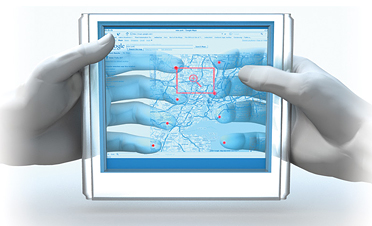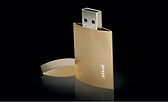Gadget With a View
Your next handheld could be see-through.

Industry:
Technology
Summary:
The Company and its wholly-owned subsidiaries design, manufacture, and market personal computers, portable digital music …
Primary executive:
Steven P. Jobs,
Industry:
Technology
Summary:
The Company develops, manufactures, licenses, and supports a range of software products for many computing devices.
Primary executive:
Steven A. Ballmer,
Five years ago, Patrick Baudisch found that it was getting harder to
dial the minuscule buttons on ever-smaller cell phones; he couldn't see
what he was tapping on the keypad while he was holding the phone. What
he really needed, he decided, was fingers he could see through. So
Baudisch, a scientist at  Microsoft
Research who was studying human-computer interaction, started working
on something more practical: LucidTouch, a digital technology meant to
give handheld devices the illusion of transparency. An unusual joint
venture formalized in 2006 between Microsoft and Mitsubishi Electric
Research Labs, LucidTouch is designed to allow the use of all 10
fingers, unlike the BlackBerry or Treo. It has two touchscreens: one in
front of the device, for thumbs, and the other in back, where the
fingers (which appear onscreen as digital facsimiles) hold the device
and type. The inventors envision creating sensors for the back to do
the same job as the camera that’s on their prototype. Another goal:
multipoint selection, which lets users pinch, zoom, and drag onscreen
icons using several fingers, unlike traditional touchscreens, which
respond only to single pokes in particular spots. (Even
Microsoft
Research who was studying human-computer interaction, started working
on something more practical: LucidTouch, a digital technology meant to
give handheld devices the illusion of transparency. An unusual joint
venture formalized in 2006 between Microsoft and Mitsubishi Electric
Research Labs, LucidTouch is designed to allow the use of all 10
fingers, unlike the BlackBerry or Treo. It has two touchscreens: one in
front of the device, for thumbs, and the other in back, where the
fingers (which appear onscreen as digital facsimiles) hold the device
and type. The inventors envision creating sensors for the back to do
the same job as the camera that’s on their prototype. Another goal:
multipoint selection, which lets users pinch, zoom, and drag onscreen
icons using several fingers, unlike traditional touchscreens, which
respond only to single pokes in particular spots. (Even  Apple’s
iPhone limits users to two-finger touching.) Industry observers expect
LucidTouch to be ready for cell phones, gaming devices, and
wristwatches within five years, although some participants in an early
focus group found its nontraditional keyboard awkward. "The backs of
devices are underused real estate," says Scott Klemmer, a Stanford
University computer-science professor. "We're not doing anything with
them right now."
Apple’s
iPhone limits users to two-finger touching.) Industry observers expect
LucidTouch to be ready for cell phones, gaming devices, and
wristwatches within five years, although some participants in an early
focus group found its nontraditional keyboard awkward. "The backs of
devices are underused real estate," says Scott Klemmer, a Stanford
University computer-science professor. "We're not doing anything with
them right now."
Posted: Jan 15 2008 1:02pm ET
This
is an awesome idea, but it's got some issues. How are you supposed to
hold it without accidentally clicking on the rear touchscreen? This
would be extremely awkward in practice. Either you'd get more
accidental clicks than a G5-era Mac mouse, or you'd have to kind of
cradle the sides in your palms and hold your fingers out and away. Then
it'd be very easy to drop the thing. Perhaps some loops on the sides
for your hands to fit through?









